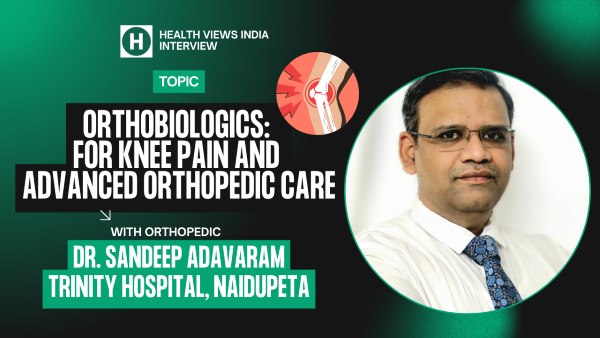Dr. Sandeep Adavaram is a leading orthopedic surgeon from Andhra Pradesh with over 12 years of experience and 7,000+ surgeries. A University topper in Orthopedics, he founded Trinity Hospital, Naidupeta, bringing advanced care to rural patients.
He is the first in Andhra Pradesh with a Diploma from the American Board of Regenerative Medicine and a member of the International Stem Cell Research Organization. Known for pioneering BMAC and MFAT stem cell therapy for knee pain, he has also introduced advanced trauma surgeries like PFN A2 and Ilizarov to rural areas.
By designing unique orthobiologic protocols for fracture healing and diabetic foot care, Dr. Sandeep has saved countless patients from amputations and made world-class treatments accessible to common people.
Q1. Dr. Sandeep, orthobiologics has become a buzzword in orthopedics. How do you see it changing the landscape of knee pain treatment?
Dr. Sandeep: Orthobiologics has been a true game changer. Traditionally, patients with severe knee pain were advised joint replacement surgeries, which many feared or could not afford. With orthobiologics like BMAC (Bone Marrow Aspirate Concentrate) and MFAT (Micro-Fragmented Adipose Tissue), we can now regenerate damaged tissues, reduce inflammation, and restore mobility—often avoiding knee replacement altogether. It is minimally invasive, safer, and gives long-term results.
Q2: Dr. Sandeep, what conditions respond best to orthobiologic treatments?
Dr. Sandeep: Based on current evidence, orthobiologic therapies show the best results in several conditions:
- Knee osteoarthritis, especially mild to moderate cases
- Chronic tendinopathies such as tennis elbow, golfer’s elbow, rotator cuff tendinitis, and Achilles tendinopathy
- Ligament injuries, particularly partial tears or chronic instability
- Plantar fasciitis, which causes chronic heel pain
- Early degenerative disc disease
- Sacroiliac joint pain
- Muscle strains in athletes
The key factor here is appropriate patient selection. Generally, younger patients with less severe degeneration respond more positively to these treatments.
Q3: And how do orthobiologics compare with traditional pain management approaches? What are the advantages?
Dr. Sandeep: Orthobiologics offer several distinct advantages over conventional pain management:
- Minimally invasive – These are outpatient procedures, often done without the need for surgery.
- Targets the root cause – Unlike many traditional methods that manage symptoms, orthobiologics promote actual tissue healing.
- Reduced dependence on medication – Patients may need fewer NSAIDs, opioids, or other pain medications.
- Lower risk profile – Since many treatments use autologous tissue (the patient’s own cells), the risk of rejection or complications is minimal.
- Faster recovery – Patients often recover quicker compared to surgical interventions.
- May delay or even prevent surgery – Particularly in cases of osteoarthritis, orthobiologics can reduce or postpone the need for joint replacements.
- Natural approach – Many patients today prefer biologic therapies over synthetic drugs, and orthobiologics align well with that preference.
Also Read: Meet Dr. Vaishaly Bharambe – Shaping the Future of Medical Education through Anatomy and Innovation
Q4. You are known for designing unique protocols with orthobiologics. Can you tell us more about these innovations?
Dr. Sandeep: Beyond knee pain, I have developed protocols using orthobiologics for fracture healing and diabetic foot management. In many diabetic patients, severe infection leads to amputation. With stem cell therapy and orthobiologics, we have saved many limbs from amputation and given patients a new lease of life. These treatments are cost-effective and accessible, which makes them revolutionary for rural healthcare.
Q5. How do patients in rural areas respond to such advanced treatments like stem cell therapy?
Dr. Sandeep: Initially, there is hesitation due to lack of awareness. But once they see real results—like walking pain-free without a knee replacement or avoiding amputation—they become the strongest advocates. Word-of-mouth in villages spreads faster than social media, and that has helped us build trust and acceptance.
Q6. Looking ahead, what is your vision for orthobiologics and regenerative orthopedics in India?
Dr. Sandeep: India has immense potential to be the global leader in regenerative medicine. We have the talent, technology, and patient pool to advance clinical research and make therapies more affordable. My vision is that every patient, whether in a metro or a small village, should have access to the latest orthobiologic and stem cell treatments without financial or geographic barriers.

“Knowledge and service should always reach the common people. Innovation in healthcare is meaningful only when it benefits the most underserved.” – Dr. Sandeep Adavaram
Contact Dr. Sandeep Adavaram on +91 9390857732 andor seek appointments at Trinity Hospital, near Mahindra Tractor showroo, Naidupeta, Sri Potti Sriramulu Nellore, Andhra Pradesh, India.




